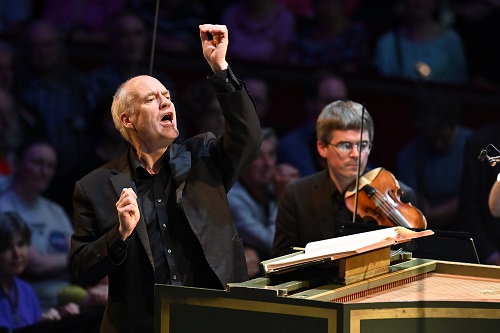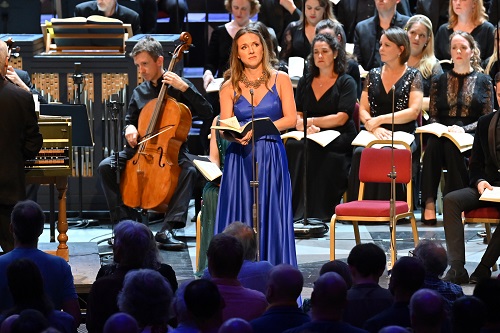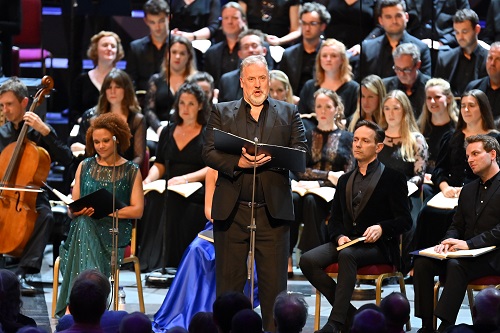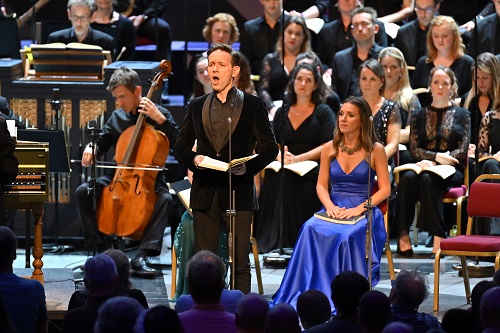Why Bach wrote the B minor Mass is a puzzle that keeps musicologists occupied. How to perform it today is a probably unresolvable question for practitioners.
The Mass began life as a sort of high-brow job application when, in 1733, Bach spotted a potential vacancy at the court of Saxony, and submitted an elaborate setting of the Kyrie and Gloria to Frederick August II, the new Elector of Saxony, in Dresden, with an effusive dedication and offering ‘a small sample of the kind of scholarship I have attained in musique’. We don’t know whether the movements, scored for large instrumental forces and five soloists, were ever performed, and Bach didn’t get his hoped-for position – Composer to the Electoral Saxon and Royal Polish Court – for another three years. Moreover, he didn’t complete his Mass, for which he reused and refashioned existing material, until 1748. He almost certainly didn’t expect the Mass to be performed in a liturgical context: its length – just under two hours – and scale make it inappropriate for either Lutheran or Catholic services. So, was it a ‘legacy work’ – like the Art of Fugue, the Goldberg Variations and the Musical Offering, designed to showcase Bach’s mastery of his art?
Today, it’s become a concert piece – and a magnificent one, described by its first publisher Hans Georg Nägeli as the ‘greatest musical work of art of all times and nations’. As the ever well-informed and reliable David Gutman points out in the programme for this Proms performance by the Choir and Orchestra of the Age of Enlightenment under John Butt, since the mid-1970s period-instrument style has held sway, both at the Proms and on recordings. The English Concert under Harry Bicket fielded a 42-strong chorus and an orchestra of 51 musicians at the Royal Albert Hall in 2012. In 2016, William Christie’s Les Arts Florissants comprised just 25 singers and 29 instrumentalists.

John Butt elected for 43 players and a choir of 50. He positioned the performers in an unusual configuration, with the choir rear-right and the five soloists seated before them, and the musicians fanning out to the left from his own centrally placed harpsichord, the four flutes, three trumpets, timpani, four oboes, two bassoons and horn forming a circle around the strings and organ. There was perhaps a danger that this arrangement would exacerbate the acoustical challenges of the Hall, with audiences on left and right of the auditorium having very different listening experiences, one foregrounding the instrumentalists, the other the choir, who were angled inwards towards Butt, and soloists.
Judging from my seat in the left stalls, not all the singers projected with equal strength and fullness, and the positioning meant that the obbligato instruments could hardly create intimate conversations with their vocal partners in the arias and duets. Moreover, given that 18 out of 27 movements are written for chorus, one wonders why the arias are not more often given to consort singers – Bach would surely have envisaged that, whatever forces were employed, the soloists would have come from the choir. As it was Mary Bevan (soprano 2), having sung her duet and solo at the start had to sit metaphorically twiddling her thumbs for most of the two-hour performance – one imagines that she might have liked to join in those fabulous choruses!

And, they certainly were ensembles of drama, majesty and celebratory joy. Butt strove for continuity, minimising the breaks between movements and often running on segue. The opening ‘Kyrie’ was quite spacious but, though the counterpoint was clearly layered, lacking in a real sense of urgency in its pleading – those ‘leans’ can be more weighted and pained, but perhaps that only comes from smaller forces in a more intimate venue? I thought that the text here could have worked harder, but there was a lovely ‘smoothness’, and if perhaps we could have had a bit more bass from both the singers and instrumentalists then everything was beautifully cultured, as it would be throughout the performance. Sopranos Rachel Redmond and Mary Bevan duetted charmingly enough in the ‘Christe eleison’ but there wasn’t much light and shade here, and it sounded as if the soloists were working out the acoustic – their subsequent contributions were more telling.
The second ‘Kyrie’ was more purposeful, though; the alla breve tempo had a new vigour and vocal accents made more of a mark, as Butt shaped the rise of the vocal phrases pointedly. There was nothing austere about the counterpoint. And the arrival of a vigorous timpani (Adrian Bending) and deliciously silvery trio of trumpets, led by David Blackadder, in the ‘Gloria’ pepped things up further, though occasionally the tenors of the choir seemed to be striving a bit too hard to match them for brilliance and élan. The ‘Gratias agimus tibi’ passage had both breadth and momentum, and Bending added some bite and beef towards the close, though I felt that the text of the ‘Qui tollis peccata mundi’ could have been more expressively weighted – more bass, please, and more harmonic nuance.
The ‘Credo’ was sung with terrific conviction – they really did believe – and the ‘Et incarnatus est’ was a highlight. Those descending arpeggios and expressive harmonies were terribly poignant, and the violins’ ‘weeping’ was as tender as could be above the steady, resigned crotchets of the bass and organ. Butt rightly made this ‘Incarnation, Crucifixion and Resurrection’ sequence the heart of the whole – unfussy, direct, deeply communicative. ‘Et resurrexit’ pushed forward with terrific vigour and brightness. And by the time we reached the ‘Sanctus’ and ‘Osanna’ things really got into their stride – there was tremendous drama here, reminiscent of the Passions.

Mary Bevan and OAE leader Huw Daniel were stylish partners in the ‘Laudamus Te’, rhythms taut, phrases shapely, though Bach’s nod to the opera house didn’t carry resoundingly to my part of the Hall. Similarly, who could fault the attractive singing of Redmond and tenor Guy Cutting in the ‘Domine Deus’, though they were somewhat distanced from the flutes, and it was difficult, as a listener, to integrate the various voices in the dialogue. The same problem occurred in the ‘Quoniam tu solus sanctus’ where the expanse between horn-player Roger Montgomery – playing with terrific panache – and bass Matthew Brook was distracting, though both conjured robust spiritual conviction. Brook’s ‘Et in Spiritum Sanctus’ made much more of a mark – the phrasing was elegant, the tone immensely gratifying, the text respected: absolutely lovely singing. Flautist Lisa Beznosiuk was a dulcet partner in Cutting’s ‘Benedictus qui venit in nomine Domini’, which had an air of purity, reverence and wonder.

Of the soloists, countertenor Iestyn Davies was in a league of his own, though. How does he do it, time and time again? The fulsome beauty of his tone, particularly in the upper regions; the effortless projection; the nuanced shading, without mannerism, of every phrase. It’s simply stunning. I held my breath through both the ‘Qui sedes’ and the ‘Agnus Dei’. One listener to the radio broadcast remarked to me that they were put in mind of Chaucer’s description of the Pardoner who makes his voice ‘rynge [it] out as round as gooth a belle’ – though one would add that Davies soars with sweetness and sincerity not subterfuge and sinfulness. The long phrases of ‘Qui sedes’ were beautifully creamy without being affected, and were lovingly complemented by oboist Katharina Spreckelsen. No deity could surely deny this prayer for mercy.
Davies’s duet with Redmond, ‘Et in unum Dominum’, was nimble but certainly not light-weight, and there was some lovely string playing here, varied articulations used to expressive effect. The opening note of the ‘Agnus Dei’ was so effortlessly placed it seemed that it must have been ringing in the celestial ether, waiting to be sounded in earthly realms. The richness of Davies’s lower register was beautifully communicative here. I’m not sure if it’s ‘right’ to hear both spirituality and sensuality in this aria, but Davies’s singing was manifold and heart-touching in its expressiveness. The Hall was silent, still, rapt.
I would have liked a longer pause before Butt unfolded the closing ‘Dona nobis pacem’ chorus but it had a fitting and comforting stateliness. And, why couldn’t the Prommers let the music settle before bursting into rich applause? But, this powerful performance did make one have hope that, perhaps, when the world seems on course for self-destruction, that there could be hope and redemption.
Claire Seymour
Bach: Mass in B Minor
Rachel Redmond and Mary Bevan (sopranos), Iestyn Davies (countertenor), Guy Cutting (tenor), Matthew Brook (bass), Choir of the Age of Enlightenment, Orchestra of the Age of Enlightenment, John Butt (conductor).
Royal Albert Hall, London; Monday 29th August 2022.
ABOVE: Bach’s B minor Mass at the Royal Albert Hall (c) Chris Christodoulou